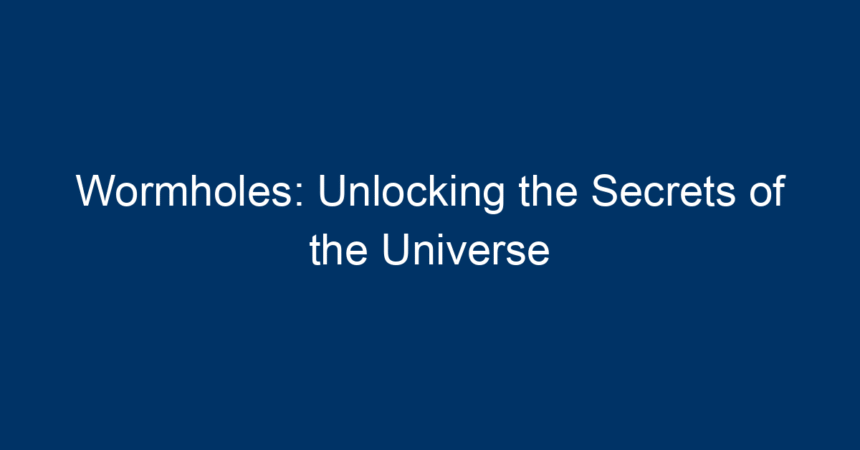The cosmos has always captivated human imagination, inviting us to ponder its mysteries and explore the uncharted realms of space and time. Few concepts have sparked as much intrigue—and debate—among scientists and enthusiasts alike as wormholes. These theoretical passages through spacetime promise a shortcut between distant points in the universe, but what are they really? In this comprehensive article, we will delve into the fascinating world of wormholes, exploring their theoretical underpinnings, types, implications for time travel, and much more. Buckle up as we venture into the cosmic unknown!
What Are Wormholes?
To understand wormholes, we first need to grasp the fundamentals of spacetime. Time and space, traditionally viewed as separate dimensions, are intertwined into a single four-dimensional continuum. Wormholes, initially conceived through Albert Einstein’s General Theory of Relativity, are theoretical bridges connecting two distinct points in this spacetime fabric.
Imagine folding a piece of paper so that two points touch. A wormhole works similarly; it creates a shortcut through the universe. This concept opens a Pandora’s box of questions about the nature of reality, travel beyond our solar system, and even the potential for time travel.
The Science Behind Wormholes
Wormholes arise from solutions to the equations of General Relativity. The simplest model, the Einstein-Rosen bridge, suggests that a wormhole connects a black hole to a white hole. While black holes are regions from which nothing escapes, white holes theoretically release matter into the universe.
However, traversable wormholes, capable of allowing matter and information to move from one end to another, remain a theoretical construct. Physicists like Kip Thorne have posited that these could exist under specific conditions, but their construction appears beyond our current technological capabilities.
Types of Wormholes
Wormholes can be categorized into several types based on their characteristics:
-
Schwarzschild Wormholes: These are non-traversable and consist of a black hole and a corresponding white hole.
-
Traversable Wormholes: Proposed by Kip Thorne, these can potentially allow travel for matter. They require exotic matter with negative energy density to keep the wormhole mouth open.
-
Lorentzian Wormholes: This category includes the traversable wormholes proposed by Thorne and others, wherein the geometry allows for time travel.
- Kerr Wormholes: These would be rotating wormholes, allowing for some unique properties, such as frame-dragging effects.
Each of these wormhole types comes with its own unique set of challenges and implications, leading us to explore their feasibility and the foundational physics governing them.
Are Wormholes Real?
While wormholes are grounded in theoretical physics, the question remains: Are they real? Currently, there is no empirical evidence for the existence of wormholes. Their validation hinges on technology and observations potentially far beyond our current reach.
However, scientists remain optimistic. Projects like the Event Horizon Telescope, which captured the first image of a black hole, signal a burgeoning capability to explore these cosmic phenomena. Future advancements in observational technology or even quantum computing might reveal clues that bolster the theoretical foundations of wormholes.
The Role of Exotic Matter
One of the most intriguing aspects of traversable wormholes is the need for exotic matter. Unlike normal matter, which has a positive energy density, exotic matter can have negative energy density and pressure, theoretically providing the stability required to keep a wormhole open.
This is where the dreams of scientists and dreamers alike intertwine. Some have hypothesized regarding the existence of dark energy or certain quantum field theories that might produce the necessary exotic matter.
Time Travel: A Possible Consequence of Wormholes
One of the most tantalizing implications of the existence of wormholes is time travel. The idea that one could traverse a wormhole and emerge at a different point in time has captivated science fiction narratives and philosophical debates alike.
But how does this work? The theoretical framework suggests that by taking a path through a wormhole, one could arrive at a point in history either in the past or the future. However, this concept raises paradoxes, such as the infamous ‘grandfather paradox,’ where interactions in the past could alter the present.
The Implications of Wormholes on the Universe
The existence of wormholes could fundamentally alter our understanding of cosmology and the universe. Imagine if interstellar travel were possible within a manageable timeframe. Human exploration of far-off galaxies would no longer be a matter of centuries but could happen within hours.
-
Interstellar Communication: Instead of relying on signals that might take years to reach another planet, wormholes could facilitate instantaneous communication.
-
Cosmic Discovery: Theoretical wormhole networks could enable us to explore celestial bodies that are currently beyond our reach.
- Philosophical and Ethical Questions: If travel across time and space became feasible, we would need to consider the ethical implications of interacting with different time periods and civilizations.
Challenges and Theoretical Limitations
Despite the thrilling possibilities that wormholes present, several significant challenges stand in the way of their existence:
-
Energy Requirements: The energy needed to create or stabilize a traversable wormhole may be beyond what is attainable with current technology.
-
Stability Issues: Even if a wormhole could be created, maintaining its stability long enough for safe travel poses significant hurdles.
- Exotic Matter: The search for exotic matter continues, but until it is discovered or synthesized, traversable wormholes remain purely theoretical.
Conclusion: The Future of Wormhole Research
As we conclude our journey through the enigmatic world of wormholes, it is clear that while they remain a concept of theory and speculation, they elevate questions fundamental to our understanding of physics and the universe. Their study invites a blend of rigorous scientific inquiry and imaginative exploration.
For those captivated by the mysteries of the cosmos, there are actionable insights to consider:
-
Stay Informed: Keep an eye on developments in physics, especially in areas like quantum mechanics or cosmology.
-
Engage with Science: Explore educational sources, attend seminars, or participate in discussions to deepen your understanding of theoretical physics.
- Embrace Imagination: Consider the ethical implications of advanced technologies, including theoretical time travel and interstellar exploration.
As we continue to unravel the fabric of our universe, the secrets of wormholes may one day transition from speculative theories to groundbreaking discoveries that could change our place in the cosmos forever. The future remains not only in the hands of scientists but also in the hearts and minds of those who dare to dream.
This article provides a detailed overview of wormholes, catering to a broad audience while ensuring SEO optimization through strategic keyword placement.




